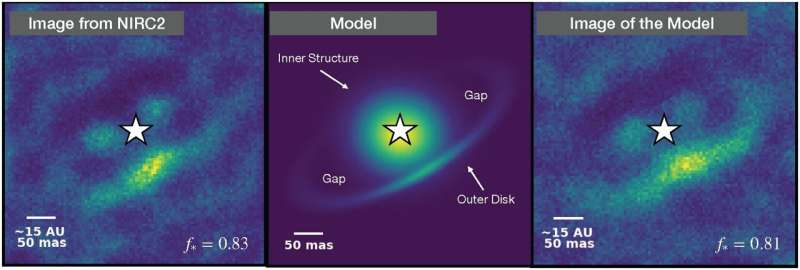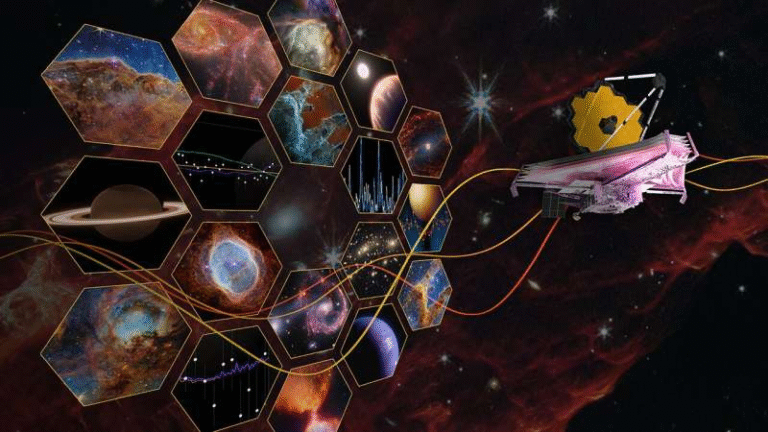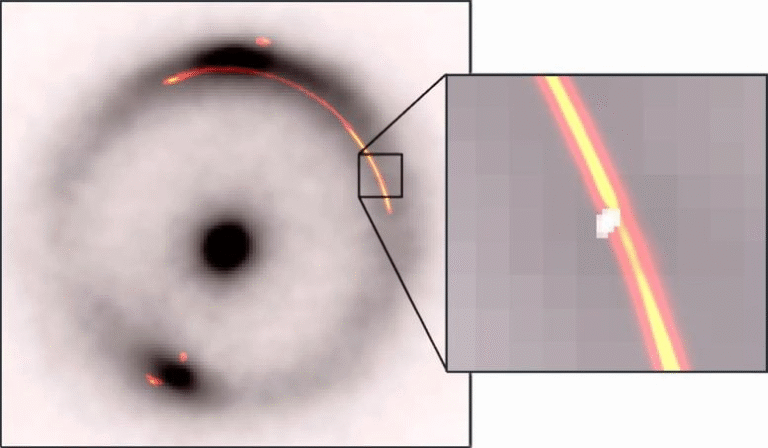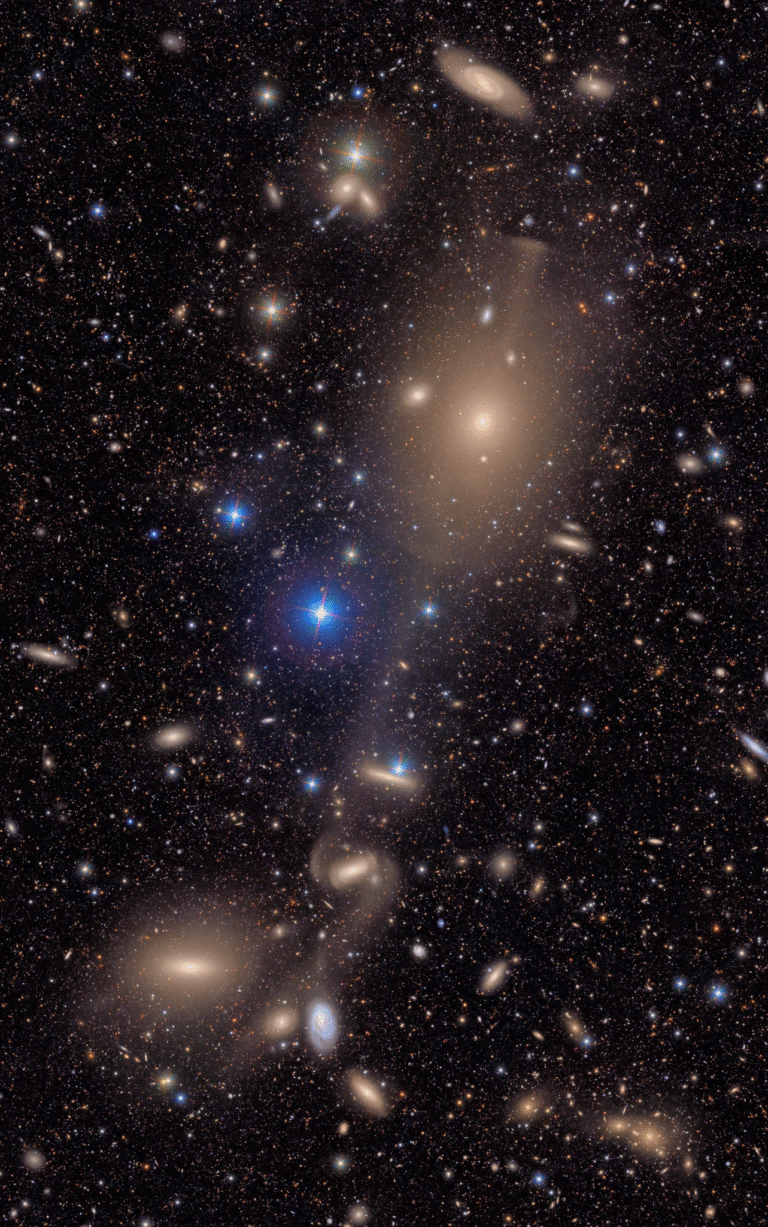Astronomers Use SPAM to Capture the Closest Look Yet at Planets Being Born Around a Young Star

Astronomers have taken the closest-ever look at the dusty region where planets form, revealing fascinating new details about a young star system located roughly 400 light-years away. The work, carried out with the W. M. Keck Observatory in Hawai‘i, used an advanced observing program known as the Search for Protoplanets with Aperture Masking, or SPAM for short. This ongoing project is uncovering how planetary systems like our own come into existence, one young star at a time.
The star at the heart of this new study, HD 34282, is surrounded by a thick disk of gas and dust—a structure astronomers call a transition disk. These disks are the birthplaces of planets, where swirling material slowly clumps together under gravity to form new worlds. The Keck team, led by Christina Vides, a graduate researcher at the University of California, Irvine, captured the most detailed near-infrared view ever made of this kind of disk.
Using the Near-Infrared Camera (NIRC2) instrument at Keck Observatory, the researchers applied a special imaging technique known as aperture masking interferometry. This method involves covering part of the telescope’s primary mirror with a patterned mask, allowing astronomers to combine light from several smaller “sub-apertures.” The result is a dramatic improvement in resolution—letting scientists see much closer to a star than traditional imaging methods permit. In this case, that meant getting an unprecedented look just a few astronomical units (the distance between Earth and the Sun) from HD 34282 itself.
What the Observations Revealed
The images show that HD 34282’s disk isn’t smooth or uniform. Instead, it’s made up of clumpy, uneven regions and brightness variations, suggesting ongoing planet formation activity. A clear gap—roughly 40 astronomical units wide—separates an inner structure of dust from the larger protoplanetary disk that surrounds it. Gaps like this are often a telltale sign that a young planet is sweeping up material as it orbits its host star, carving out a lane in the surrounding disk.
The team created detailed computer models to match what Keck’s NIRC2 camera observed. The best-fitting model suggests that the inner structure may be a circular envelope of dust, possibly an early stage of planet formation close to the star. The outer disk, meanwhile, extends much farther out, with the 40 AU gap marking a likely site where planets are taking shape.
Although no protoplanet was directly detected, the data provide strong clues about where one might be hiding and the conditions that make its formation possible. The team also estimated the mass of the star and its accretion rate, which describes how quickly material is falling onto it—an important factor for understanding how the disk evolves over time.
Importantly, the researchers ruled out previous claims of a massive companion object. Earlier studies suggested a potential 50-Jupiter-mass body might exist within the disk, but the new Keck data showed no evidence for anything larger than 40 Jupiter masses within their detection range.
Why This Discovery Matters
Detecting forming planets directly is one of astronomy’s biggest challenges. In fact, only two confirmed protoplanets—PDS 70 b and PDS 70 c—have ever been imaged so far, both discovered using the same Keck instrument in 2020. The new HD 34282 study adds a crucial piece to this puzzle, providing the tightest observational limits yet on where a planet could exist within that system’s disk.
This research is also a major technological milestone. Keck Observatory’s adaptive optics system, combined with aperture masking, makes it possible to resolve structures at scales smaller than 10 milliarcseconds—equivalent to spotting a dime from more than 100 kilometers away. That capability allows astronomers to peer directly into the planet-forming regions that were once completely invisible.
By refining these methods, astronomers are inching closer to catching the moment when dust and gas begin to coalesce into a brand-new planet. Every system like HD 34282 brings us a step nearer to understanding how our own solar system came to be.
A Growing Project
The SPAM program has so far observed about 30 young stellar systems, each one a unique experiment in planet formation. The acronym may sound light-hearted, but the science behind it is anything but. These observations are designed to identify “transition disks” and other early-stage environments where planet formation is actively underway.
The team plans to continue its work with the Keck Observatory’s powerful instruments, expanding the SPAM survey to include more young stars and more disk types. Upcoming technology, such as SCALES, a next-generation high-contrast imager now being built for Keck, will make it possible to detect even fainter companions and see finer details in the dusty environments where planets take shape.
How Planetary Birth Works
When stars form from collapsing clouds of gas and dust, leftover material forms a protoplanetary disk around them. Over millions of years, particles in these disks collide and stick together, gradually forming larger bodies that grow into planets, moons, and asteroids.
Transition disks, like the one around HD 34282, are a special kind of disk showing large cavities or gaps—evidence that planets may already be forming inside. These gaps can form as newly created planets gather up dust and gas from their orbital paths, leaving behind less material in those regions.
HD 34282’s disk, with its clearly defined inner and outer components, provides an excellent laboratory for studying these processes. Past ALMA (Atacama Large Millimeter/submillimeter Array) observations revealed that the outer ring stretches from roughly 78 AU to 374 AU, reinforcing the view that HD 34282 is a highly structured, actively evolving system.
The Keck results add near-infrared details to this picture—showing what the smaller dust grains closer to the star are doing, rather than just the larger millimeter-sized particles that ALMA detects. The combination of these datasets offers a much fuller understanding of how planet-forming disks behave at different scales and wavelengths.
The Future of Planet Formation Studies
As observational technology advances, astronomers are moving closer to directly watching planets take shape in real time. Instruments like Keck’s NIRC2 and upcoming facilities such as SCALES or even the James Webb Space Telescope provide complementary tools to capture these faint signals.
Each observation helps fine-tune models of how material moves, clumps, and interacts in young disks. That, in turn, helps explain why some systems form giant gas planets while others end up with rocky worlds like Earth. Studies like this one of HD 34282 are building a more complete timeline of how planetary systems evolve—from a cloud of dust to a family of fully formed planets.
The team’s next step will be to monitor HD 34282 and other SPAM targets over time. By watching how light patterns and disk structures change, astronomers can identify whether planets are growing, migrating, or influencing the material around them. Future high-contrast imaging may even reveal new companions in the gap that Keck’s current observations have hinted at.
Looking Ahead
While the name SPAM may make people smile, the project represents a serious leap in our ability to study planet formation directly. From the earliest dust clumps to fully fledged worlds, this research helps answer one of humanity’s oldest questions: how do planets like Earth come into being?
With every new target, instruments like Keck’s NIRC2 push the boundaries of what’s visible, giving us a clearer view of the very beginnings of planetary systems. HD 34282 is just one of many cosmic nurseries being investigated—but its intricate disk and newly measured features are already helping astronomers refine their understanding of how new worlds are born.





